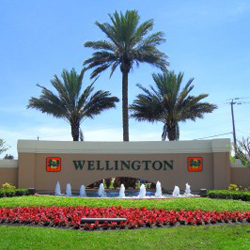Residents of the Saddle Trail community will have the opportunity to weigh in on whether Wellington should assess residents to pave community roads, build bridle trails and install municipal water services.
At Tuesday’s Wellington Village Council meeting, residents of Saddle Trail came out to ask council members to do so, citing concerns of dust, traffic and safety hazards.
“We need to separate the horses from the roads,” resident Gino Digioacchino said. “It’s an accident waiting to happen. We’re not asking for any monetary help. We’re going to pay for this. We just need you to help us get to the next step.”
About 72 residents in the south Saddle Trail community — located south of Greenbriar Blvd. — signed a petition asking the council to let them use Wellington’s special assessment process for the project. Two homeowners did not support the project, while 31 residents did not respond.
Residents of Saddle Trail’s northern portion also asked council members to be included, though a petition was not circulated there.
Village Engineer Bill Riebe told council members the project would include paving existing shellrock roads, constructing a 10- to 15-foot bridle trail on one end of the roadway, reworking drainage swales, and installing new drinking water pipelines and fire hydrants in the neighborhoods.
“The property owners are going to pay for all the costs,” he said. “The proposal would be an annual assessment that would show up on their tax bill each year. The assessment share would be determined by acreage, but that could be changed.”
Riebe said past councils have required a super-majority of residents in a community to support such an assessment before approving it.
If the council agreed, the next step would be to do a formal poll of the community, before moving into more specific plans. “There will be plenty of opportunity for the public to give input,” Riebe said.
Councilman Matt Willhite asked how Wellington would manage traffic and speeding, and Riebe said they could install traffic circles or other measures.
Willhite then asked how it would be paid. “We create a bond and back charge the residents until the bond is paid off?” he asked.
Riebe confirmed that would be the likely funding method.
The majority of residents spoke in favor of the measure.
Resident Gary Charboneau said the plans began more than four years ago as a dust control measure, but have grown to include infrastructure and safety improvements.
“It’s a safety issue for horses and humans,” he said. “You see carts, horses, trucks, trailers and all kinds of vehicles on the road at the same time. All the changes would benefit all the residents in south Saddle Trail.”
Kelly Caldwell Sachs said that her son has been sick, and doctors determined that the dust from the dirt roads has been a contributing factor.
“We found that the dust problem is what is causing massive problems in his lungs,” she said. “He’s tiny, he’s only three, and he’s sick every single day. The dust is a massive problem. I think it’s time we finally pave these roads.”
Sachs said traffic has been an issue, noting that several riders have been injured because of trucks or other large vehicles spooking horses. “We need help,” she said. “We want safety. We want fire hydrants. We want all the thing every other neighborhood in this community has, and we’re willing to pay for it.”
But resident Linda Elie worried that the paving would cause more flooding and more traffic issues.
“You’d be replacing the [dirt roads] with an impervious surface,” she said. “Also, I’ve never seen vehicles go slower on paved roads than dirt roads.”
Sherri Wolf, who lives in the northern part of Saddle Trail, asked that the council poll the entire community. “All we’re asking is when you send out the poll of who would like this, you include the whole of Saddle Trail,” she said. “We have the same problems with the traffic, dust and water.”
Vice Mayor Howard Coates asked what it would take to include the north part of the community.
Riebe said it would take a bit more work, because residents of the south portion had already done cost analysis and other measures. “The resident group did a lot of that work,” he said. “It’s not that we can’t do it.”
Councilwoman Anne Gerwig suggested polling the entire community before continuing with the project. “It seems like [the issues] affect both sides,” she said.
Schofield said Wellington can poll both sides, but suggested it is done separately. “This is the first step,” he said. “If you want to take the first step on both sides, that’s a relatively easy thing to do.”
He said if the council approved it, Wellington probably would have to hire a consultant to do the poll, which could cost $5,000.
Willhite made a motion to move ahead with the polling, which passed unanimously.








